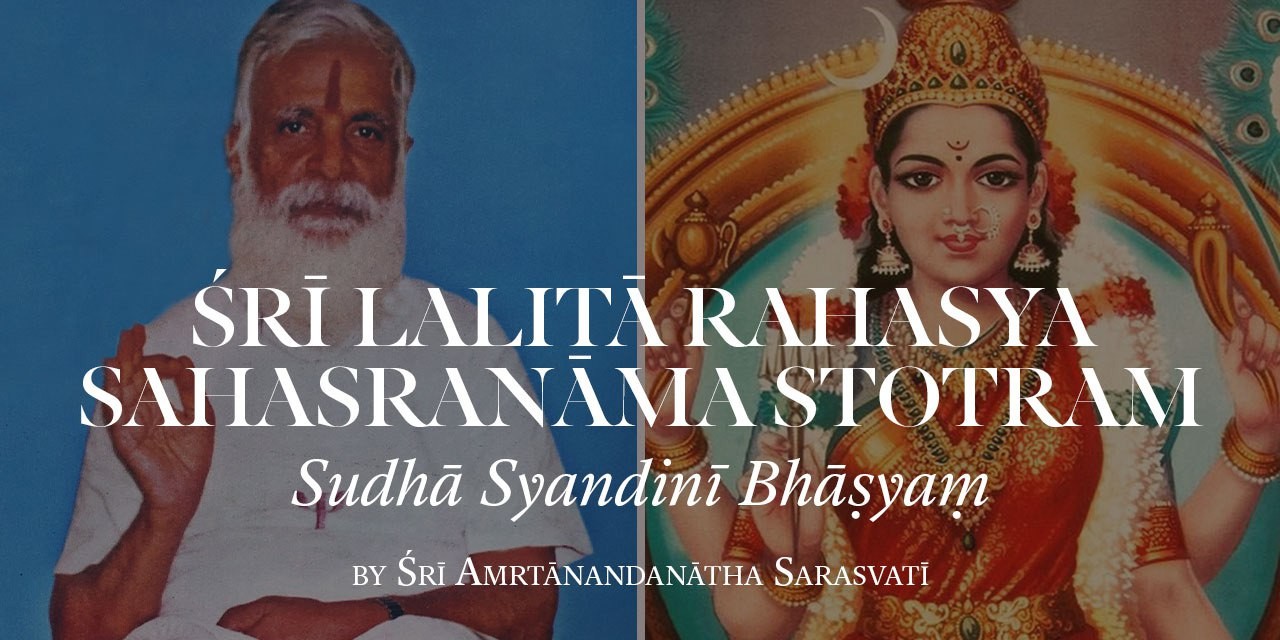
57) Cintāmaṇi-gṛuhāntasthā
Lalitā resides in a house called Cintāmaṇi, meaning the jewel of thought.
(g.) There is a beautiful description of Cintāmaṇi Gṛha in Lalitopākhyāna and also in Devi Bhagavatam. This house is situated in Śrī Cakra, described as follows.
There is an ocean of nectar in which there is an island of jewels. In it, a garden of many big and beautiful wish-fulfilling trees, a tree which gives children to the childless, sandal wood forest, a garden of hibiscus trees (red mandara trees), of white lilies (parijata), all kinds of flower beds abound. Then there are the nine walls made completely of the nine kinds of jewels;
Puṣparāga [Topaz or Yellow Sapphire]
Padmarāga [Ruby]
Gomedaka [Hessonite]
Vajra [Diamond]
Vaidūrya [Cat’s eye]
Indranīla [Blue sapphire]
Muktāphala [Pearl]
Vidruma [Coral]
Māṇikya [Ruby]
There are additionally two open houses of rubies and a hall of a thousand diamond pillars. In it, there is a well of immortality, and another well of beauty and bliss and discrimination. The rising sun itself and the full moon are forever present. There is the great hall of erotic love, which is also the abode of a thousand petalled thousand lotuses.
There is the Cintāmaṇi Gṛha which has four entrances one each along the east, south, west and north. Then there is the set of three ruby circular steps, inside of which there is an exquisite throne. The four supports of the throne are the lesser gods Brahmā, Viṣṇu, Rudra, and Īśvara. The top of the throne is Sadāśiva (the formless God known as the liṅga) resting on a bed of swan downs, on which a red velvet bedsheet, a gentle breeze maker, and a curtain called the great illusion of multiplicity exist. Lalitā is on top of Sadāśiva forever coupled to him, and giving life to the corpse like Sadāśiva.
(s.) The subtle meaning of all this is that the physical and mental body of the aspirant is itself the Cintāmaṇi Gṛha. Here the Cintāmaṇi is a mantra called by the same name which goes thus "Oṁ Hrim". This mantra is sometimes called the Siddha Cintāmaṇi. The place of meditation for this mantra is Ājñā cakra; when the bīja (seed letter) Kroṁ is added, the Oṁ is read as “Ām”, which then becomes the mantra for infusing life into an idol, or alternatively, to enter another's body, technically known as parakāya praveśa. It is interesting to note that this Siddha Cintāmaṇi consists of the bījas Ām Hrīṁ denoting the Paśa Śakti or attractive interactions and Kroṁ the Aṅkuśa Śakti or, the repulsive interactions of Lalitā. Neither attractive interactions alone nor repulsive interactions alone can create a bond state, because the attractive interactions alone can only lead to a merger of identity whereas the repulsive interactions alone will push two particles out to infinite distance between then. When both exist together with different ranges or regions of operation, then a bound state can result. Binding is the most elementary conception of organization, which can lead to life. The bija Ām is the Brahman who wishes to become many.
The bija Hrīṁ has two sain meanings. The first is, Ha = Śiva, Ra = fire. Ī = desire, Ṁ = contact with. Thus Hrīṁ means the liṅga of God emitting the fiery seed of desire contacting. Contacting what? Contacting Kroṁ, meaning Ka = Procreative Brahman, Ra = fire, O = A + U = Śiva + Viṣṇu, that is, Time and Space.
Thus it is that Ām Hrīṁ Kroṁ mantra has the power to create a life form through binding as a result of attractive and repulsive interactions simultaneously present in certain regions of space and time.
This last implication of confinement in space and time comes about from the second main meaning of Hrīṁ, which is a combination of Hari, Hara and Viriñci (hri) getting together, that is, the forces of creation, sustenance and destruction getting together. Without Brahmā, there can be no creation at any level; without Viṣṇu the creation won't last any length of the time because of the destructive power of Śiva, the time. So it is that whatever is created must come to an end. If something is to last forever, then it must never have been created in the first instance, or it must have been an entity beyond space and time.
(c.) On the causal plane the witness in the individual sees a many splendored fixed object in his meditations when his mind stops functioning. The witness is lost in silent wonder of the glorious spectacle in front of his mental eye. The witness knows that he is seeing his own invariant form beyond the confines of time.
(t.) When the individual witness merges into the universal witness, he has become the God himself as all boundaries are lost to him. Truly that is the state in which all opposites unite, called the great kula.
Source: Śrī Amṛtānandanātha Saraswatī "Sudhā Syandinī Bhāṣyaṃ" Typed Manuscript
(an incomplete commentary on Lalitā Sahasranāma)
